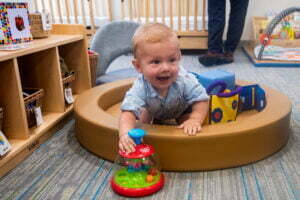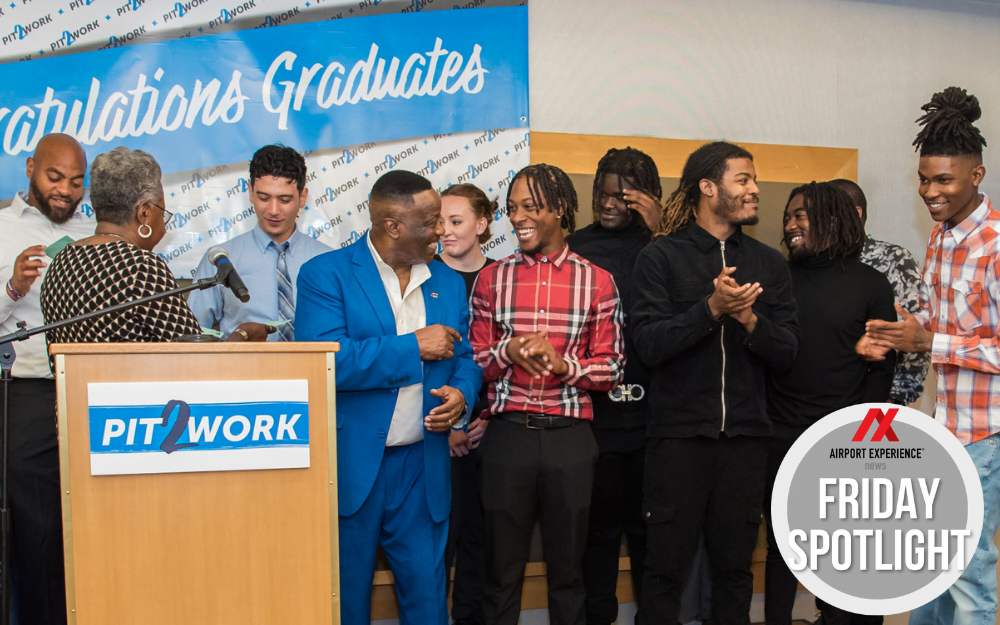Editor’s Note: In conjunction with its $1.4 billion Terminal Modernization Program, Pittsburgh International Airport (PIT) is bringing two initiatives – a pre-apprenticeship program to expand workforce opportunities for underrepresented groups, and a childcare center to support those and other airport workers – to the fore. AXN’s Carol Ward spoke with Christina Cassotis, PIT CEO, and Lisa Naylor, chief human capital officer, about the initiatives and their impact on workforce development at the airport.
Ward: First, can you update me on the modernization program underway at PIT?
Cassotis: The terminal modernization program is about halfway completed. We will be opening in early 2025. The new childcare center and all our workforce initiatives around job training were always intended to mirror the timeline of the terminal modernization program. We always wanted to use the terminal modernization program as a big advertisement [to show] all the things people can do in the construction trades at an airport. In other words, let’s use this as an opportunity to get a more diverse population into the skilled trades that would benefit us as the Allegheny County Airport Authority. It would also benefit the partners that we have.
I’m really passionate about equal access to opportunity. The childcare center, the rerouting of a bus line so that people from neighborhoods where we don’t see a lot of labor participation could get here faster, our PIT2 Work program – all of these things have been planned and are finally happening. It’s always been part of the bigger plan that we would build not just a building, but we would build the builders.
We did not do this because there’s a labor shortage. We did this because there was a shortage of representation. What I care about is that people who work at the airport reflect the community we serve.
Ward: Can you share where you are in this process? How successful you’ve been so far, and what is the goal?
Cassotis: We [recently] graduated our first PIT2Work program participants. It is a five week training program. We partnered with Partner4Work and the Builders Guild Introduction to the Construction Trades program. They toured the union halls. They toured our whole facility, understood what types of jobs are available. We held a job fair for them with the people building the terminal. Half of them were connected to trade unions and identified for employment opportunities when they graduated.
Ward: Is PIT or its partners involved in the training?
Cassotis: No. We’re the convener. Partner4Work is supporting the training by providing funding. Individuals from the Introduction to the Construction Trades program are going into the communities [recruiting those who are eligible] for this program. Then they train them, but they are making sure that what they’re training them for is what the trades need them trained for. It’s a pre-apprenticeship program to the trades, but what’s unique about it is it’s an immersive experience where the students are here on site. It’s not disconnected.
We set that up and now we’re going to scale it significantly. 86% of the participants in that program were African American and we had one woman. We know that there’s interest. We’re going to scale that into other industries, not just construction. We will look at hospitality so that we can get concession workers out here and folks who can start to look at the airport as a possible place of employment who might not otherwise have considered us.
Ward: I know many airport concessionaires have struggled to get workers to commit to on-airport jobs.
Naylor: It’s been tough for concessions. [The airport is] not very convenient to get to, and once you’re here you have to go through TSA. The wages are not keeping up with other industries. So part of the goal after this pilot program is to move it to other areas. We have applied for a Department of Labor grant for workforce development – the grant is designed to create a strategic plan to look at job quality, and emphasizes those things we are addressing at the airport, [such as] increased employee supports, childcare, training. The $500,000 planning grant will allow us to take a strategic look at ways to support our workforce within our concessionaires. Once we have a plan in place we will be able to apply for a $3 million grant to implement a plan for our airport campus where work has been a little slower to return to normal employment levels. We have opportunities here to continue this program, to support things like our Neighborhood 91 (a global hub for 3D printing at PIT), where we’re looking at additive manufacturing. Some of those employers are asking where they will we find someone to fix this very unique equipment. There’s a great opportunity to support our airport campus,
Ward: I know the initial test class was fairly small. Christina, you mentioned plans to ramp up. What does that look like?
Cassotis: We started with 14 [individuals] and 12 graduated. We’re looking at the next class being much larger. We’ll go as fast as we can based on how much money we have.
Naylor: The next class will have access to the childcare center opening in the beginning of September. We will be reserving spots for these trainees. We’re also providing transportation. It’s inclusive and we’re really looking at all the potential issues that prevent somebody from actually being successful.
Cassotis: The original vision was that this would be an enabler to this workforce development program. So we were very intentional in terms of making sure that the provider would be able to manage anybody who would qualify for state subsidies. We wanted to make sure that the folks who work on our staff as well as those who are a part of the workforce development program would’ve access to onsite quality childcare, and we wanted to make sure that [we offered] a convenience factor for working parents.
We will then be looking at [opening enrollment in the childcare center to] concessions workers or the wheelchair runners or our cleaners who may be in a position to qualify for subsidized childcare from the state. Then we would look to [workers from] any of our airline partners or TSA or CBP. We have a tiered system to make sure that we are reserving spots for people who really need access to this quality childcare on site and who may not be able to afford it elsewhere. We want this to be one of the demonstrations of the fact that we are very interested in providing people with career opportunities.






